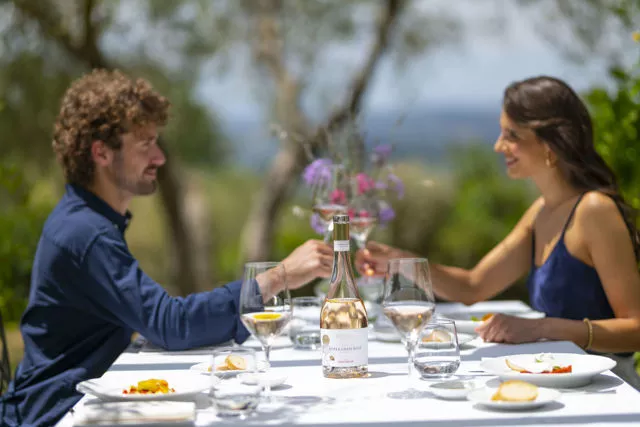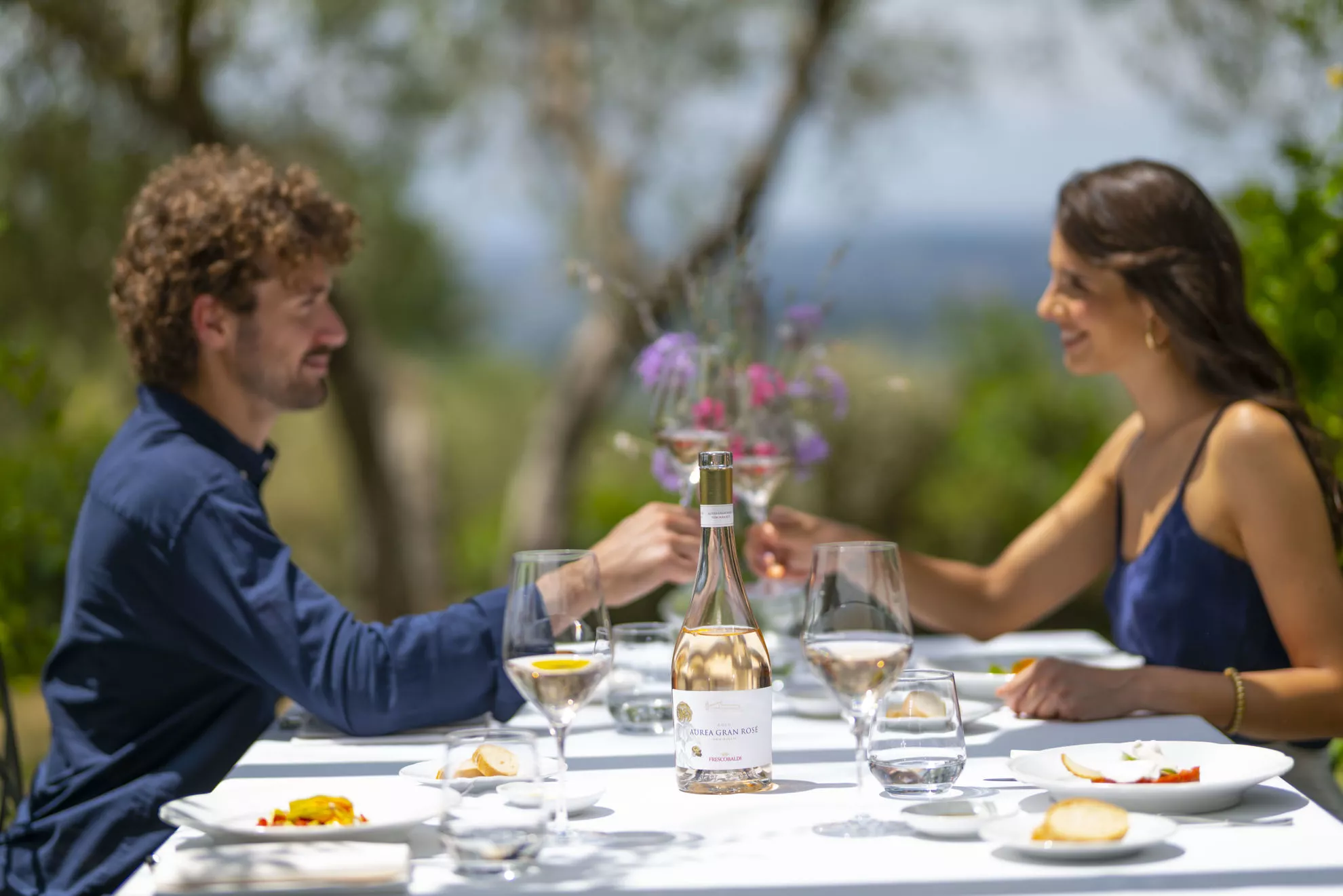
The Frescobaldi Guide To Wine Tasting
The Frescobaldi Guide To Wine Tasting
Marchesi Frescobaldi’s expert winemakers have designed this guide as a simple but useful tool for learning how to taste wine correctly. It lays out all the basic steps in evaluating a wine, starting with the visual analysis, and proceeding with an examination of the wine’s bouquet and taste. When used with the table of appropriate serving temperatures, this wine glossary by Livia le Divelec, oenologist and Frescobaldi Brand Ambassador, will offer suitable terms to express the sensations you perceive. Come join us in one of our estates and appreciate a live version of an unforgettable wine tasting.
Step One: Visual Examination
The visual examination is the first step in the sensory analysis. It gives us information often confirmed in the later olfactory and tasting examinations. The visual analysis addresses three aspects of the wine’s appearance:
1. Clarity
2. Colour
3. Weight
To judge a wine’s clarity, one must look at it against the light, holding the glass at a 45° angle over a white surface and looking down at the wine from above. If a wine is clear, it displays no particles in suspension. Otherwise, it is said to be hazy or reasonably clear. If a wine shows no suspended particles and an intense luminosity, it can be described as crystal clear.
A wine’s colour is determined by the length of contact of the must with the grape skins, a process called maceration.
A lengthy maceration gives red wines their full red colour, while a partial or brief maceration yields a rosé. Other factors that influence a wine’s colour are the temperature and length of the fermentation process, and the number of pumpovers, a “re-mixing” operation in which the fermenting must is pumped over the grape skins, which rise to form a layer, or “cap,” over the fermenting mass.
The Colour in white wines can be:
• Greenish yellow
• Straw yellow
• Golden yellow
• Amber yellow
Colour in rosés:
• Pale pink
• Cherry pink
• Claret pink
Colour in red wines:
• Purple red
• Ruby red
• Garnet red
• Orange red
A wine’s colour tells us much about its stage of development. Young white wines, for example, show light yellow tones with hard-edged, or sometimes greenish, highlights. Golden yellow, on the other hand, indicates a more evolved white wine. A passito wine or a liqueur wine will show amber, since the grapes were picked ultra - or over- ripe and thus had more time on the vine to absorb much more heat from the sun. Red wines behave somewhat similarly.
A young red wine will exhibit emphatic, forthright tones of ruby with purple highlights, whereas older reds will tend to garnet as a result of oxidation. When one sees an orange-flecked garnet, one immediately thinks of a wine that has received considerable cellaring.
In evaluating a wine’s weight, one swirls the wine in the glass, holding the glass by the base or stem. Columns of liquid, called tears or legs, will run down or adhere to the side of the glass. Their size and consistency will reveal the wine’s body and weight.
If the legs are widely separated, and the tears descend rapidly into the wine, the wine has little weight; if, on the other hand, they are close together and descend slowly, then the wine has greater weight.
Sparkling wines and champagnes merit, as usual, a separate treatment. The key element to evaluate is their effervescence, and a determination must be made of the size, number, and persistence of the bubbles. The size of the bubbles can range from coarse to pin-point, the quantity from scarce to dense, and the persistence of the bead from fleeting to long-lingering.
For sparkling wines and champagnes, the wine should not be swirled, since the evaluation focuses not on the weight but on the bead, or cascade of CO2 bubbles; the perfect bead will display a dense, long-lingering cascade of pin-point bubbles.
Step two: Olfactory examination of a wine
The olfactory examination is the most complicated evaluation of the entire sensory analysis since recognising all of the aromas released by a glass of wine can be quite challenging.
It is important to hold the glass by the stem, with the taster’s hand as far away as possible from the wine in the bowl of the glass; this will prevent any odour or perfume from interfering with the wine’s aromas.
Steps of a wine's olfactory examination:
1. Bring the glass close to the nose, and then, without agitating the wine, breathe in deeply, and then remove the glass. One can do this more than once, but with brief pauses, so as to avoid sensory fatigue of the nose.
2. Rotate the glass to form a “funnel of wine” in the glass, which helps release the various odorous compounds; this swirling movement is then repeated, but more energetically, so as to release the less volatile compounds and to the discover the very final, and often more complex, aromas.
3. The third and final analytical step is called the palato-nasal examination. After having tasted and swallowed the wine, exhale, which brings into contact the mucose membranes and other volatile compounds, freed by the temperature of the oral cavity, about 36°-37°C, and by the influence of enzymes and saliva.
The Families of Aromas
- Fruity: wild berry, cherry, plum, strawberry, sour black cherry, liqueur cherries, apple, pear, banana, pineapple, peach, apricot, citrus (lemon, lime, citron, bergamot, tangerine, grapefruit), dried fruit (apricot, fig, tropical fruit), roasted nuts (almond, hazelnut, walnut).
- Floral: acacia, hawthorn, iris, broom, elderberry, chrysanthemum, rose, violets, geranium, wisteria, magnolia, lily of the valley, orange blossom, camomile blossom, wildflowers, vine blossom, jasmine.
- Herbaceous and Vegetal: grass, leaves, mown hay, walnut husk, forest undergrowth, fern, green pepper, asparagus, algae, tomato leaf, moss.
- Aromatic herbs: sage, aniseed, fennel, laurel, oregano, thyme, basil, mint, lavender, parsley.
- Spicy: pepper, clove, liquorice, cinnamon, nutmeg, vanilla, curry powder, juniper, aniseed, saffron, ginger.
- Mineral: clay, gravel, pencil lead, ink, flint, petrol, gunpowder.
- Roasted: espresso bean, cocoa powder, caramel, toasted bread, India rubber, smokiness, toasted almond.
- Etherish: beeswax, sealing wax, sea salt.
Step Three: Taste Examination
The taste examination represents the third and final step in the sensory analysis of the wine. It is also the summarizing step since it permits us to draw a conclusion about the wine being tasted.
The Taste of a Wine
The taste of a wine is the product of three different “families” of sensations:
• Flavour: sweetness, sourness, saltiness, bitterness.
• Tactile sensations: pseudo-warmth, smoothness, astringency, prickle, thermal sensation, and weight on the palate.
• Retro-nasal or palato-nasal sensations.
The Sensations of Flavour
Sweetness
Sweetness is a pleasurable sensation of velvety roundedness experienced above all on the tip of the tongue and the mouth’s mucose membranes. When the amount of sugar in the wine is slight, we no longer speak of sweetness per se but of smoothness, which we perceive as pleasurably rounded.
Acidity
Acidity is a sensation perceptible under and along the sides of the tongue, areas that are particularly sensitive to the acids in wine (tartaric and citric). The impression is one of crispness accompanied by an increase in salivation. Still, when the level of acids is too high, the impression can become less pleasurable as a result of the slight irritation that the acids cause to the mucose membranes.
Saltiness
A micro sensations caused mainly by the mineral salts commonly present in wine, it is experienced as a very slight saltiness, perceptible above all on the sides of the tongue, accompanied by an increase in salivation.
Bitterness
Bitterish micro sensation, usually caused by polyphenols, particularly tannins. It will vary depending on how these compounds evolve. It is a pleasurable sensation perceived at the base of the tongue. To experience it, simply taste a little unmixed cocoa powder or powdered coffee.


Tactile sensations
Pseudo-warmth
Pseudo-warmth is perceived as a slight irritation. Varying levels of alcohol will give various levels of intensity; when the alcohol is more pronounced in the wine, the impression of heat becomes more intense.
Smoothness
A very pleasurable sensation that renders the wine soft and velvety in the mouth. Melting a bit of butter in one’s mouth will approximate this sensation. This impression of smoothness is caused in particular by glycerine, as well as by ethanol and any residual sugar the wine may have.
Astringency
A sensation of dryness or roughness, caused by the tannins in red wine and perceived on the tongue and oral surfaces. To experience astringency, simply sample a raw artichoke.
Prickle
The prickly sensation one receives when tasting a lightly fizzy or sparking wine, a kind of tickle on the tongue caused by the CO2, which tends to lessen the softness of the wine and to increase its firmness.
Thermal sensation
The thermal sensation is simply the perception of the wine’s temperature.
Weight on the palate
This is the sensation received from the structure or density of the wine. Related to all of the wine’s insoluble components (sugars, fixed acids, polyphenols, mineral salts, glycerine), it determines the body of the wine and is generally more prominent in red wines.
Retro-nasal or Palato-nasal Sensations
The retro-nasal or palato-nasal sensations pertain to the final phase of the tasting because they refer to the complex of aromas that one perceives after swallowing and exhaling through the nose. These sensations afford the opportunity to re-experience some of the impressions already perceived and to discover some new ones.
This is made possible by the higher temperatures that various substances display after passing through the oral cavity; these higher temperatures encourage the volatilisation of these substances.
The sensory analysis of wine focuses on its body and structure and the balance between the smooth components (sugars, alcohol, and glycerine) and hard components (acids, tannins, mineral salts).
During fermentation, the yeasts convert the sugars (in particular glucose and fructose) into ethanol. The wine will be more or less sweet if the sugars are not completely converted.
The most important and prominent alcohol in wines is ethyl alcohol, which is directly responsible for the impression of heat and makes the wine softer and more rounded by smoothing the effect of the acids, mineral salts, and tannins.
Glycerine (one of the tri-valent alcohols formed during fermentation) is the primary contributor to the smoothness of a wine.
The impression of crispness in a wine is due to the presence of acids. The acid with the highest concentration in grapes is tartaric acid.
Tannins are found in the seeds and skins of the grape; they are responsible for the sensations of dryness, roughness, and astringency in red wines.
A wine’s savouriness is determined by its level of mineral salts. The most important in wine are phosphates, sulphates, and chlorides.
Wine Serving Temperatures
The ideal temperature at which to serve red wines is around 16-18°C.
The ideal temperature at which to serve white wines is around 12°C.
The ideal temperature to serve sparkling wines and champagnes is around 6-8°C.
GLOSSARY
|
Acidity |
A sensation of crispness given by the acids in the wine |
|
Aftertaste; Finish |
The flavour impression the wine leaves in the mouth after it is swallowed. |
|
Ageing |
The maturation process to which most wines are submitted allowing the product to soften and to harmonize |
|
Alcohol |
A compound formed by the action of natural or added yeast on the sugar content of grapes during fermentation |
|
Alcoholic strength |
The percentage of concentration of alcohol contained in a wine |
|
Amber |
Term applied to a white wine whose colour is reminiscent of the glowing bronze and golden tones of amber |
|
Balanced |
When all the wine’s components (fruit, acidity, tannin, oak, sweetness) exist in harmony |
|
Cask |
Any wooden container used for wine ageing or storage |
|
Closed |
Term applied to a wine which does not release its aromas and general gustative expressions straight away. |
|
Concentrated |
Term used to describe a wine that has depth and richness of fruit |
|
Coppery |
A term applied to a wine with a copper colour |
|
Crystal clear |
Describes a wine with no suspended particles but which exhibits an intense luminosity |
|
Decant |
To pour the wine from the bottle into a decanter in order to separate the clear liquid from the solids or to oxygenate it |
|
D.O.C. |
Italy’s designation for wines whose names, origin of grapes, grape varieties and other important factors are regulated by law |
|
D.O.C.G. |
Italy’s designation for wines with somewhat stricter regulations than those for D.O.C. wines, and which also undergo taste tests for typicity |
|
Dry |
Description of a wine produced specifically to possess little or no sweetness, whereby the sugars have been almost totally fermented |
|
Elegant |
Describes beautiful, well-balanced wines |
|
Fat |
Describes full-bodied, bold, ripe, rich, flavour laden, high alcohol wines low in acidity that give a positive fat or fleshy impression on the palate |
|
Fine |
Term applied to a wine which is elegant and harmonious |
|
Floral |
Resembling or suggestive of flowers. |
|
Fragrant |
A term used to describe a wine rich with pleasant aromas |
|
Fresh |
Term applied to a wine containing a pleasant amount of acidity |
|
Fruity |
A wine in which fruit flavours dominate the aroma and taste |
|
Full-bodied |
A description for a wine that is rich in extract, alcohol and glycerine |
|
Garnet |
A dark red colour typical of the precious stone |
|
Golden |
Term applied to a white wine having a brilliant yellow colour suggesting gold |
|
Greenish |
A term used to describe a white wine with a yellow or golden colour verging on green |
|
Herbaceous |
A term used in describing the aroma of herbs in wines, typical of wines made with Cabernet and Merlot grapes |
|
Hint |
An aromatic subtlety perceived in the mouth during wine tasting |
|
Horizontal tasting |
A tasting of wines that all come from the same vintage |
|
IGT |
“Typical geographic region”: Italy’s designation for wines identified as coming from specific geographic areas, which are typically larger than DOC or DOCG zones |
|
Late Harvest |
A term referring to wines made from grapes picked towards the end of the harvest when they are very ripe, and thus containing a greater percentage of sugar |
|
Light |
Term applied to wines light in alcohol |
|
Limpid |
A term used to describe a wine which is clear, bright and crystalline, without particles that may make it turbid |
|
Lively |
A term used to describe youthful and fresh wines, usually with good acidity |
|
Long-lasting; long |
Term applied to a wine whose aromatic expressions linger in the mouth a long time after swallowing |
|
Magnum |
A large bottle equivalent to 1,5 litres |
|
Mature |
A term applied to a wine which has fully developed or matured and is ready to be consumed |
|
Persistent |
A term which generally describes the length of a wine’s finish or aftertaste, roughly synonymous with “long” |
|
Powerful |
Describes a wine high in alcohol, tannin and/or extract, often with assertive flavours |
|
Robust |
A term describing a full-bodied wine |
|
Round |
Describes a well-balanced wine with soft or matured tannins, and low acidity |
|
Ruby |
A term applied to the lively red colour of a wine |
|
Small barrel |
A container of 255 – 228 litres, made of wood, most typically oak, used to age wine. |
|
Soft |
A term describing a wine is one that is round and fruity, low in acidity, and without aggressive tannins |
|
Sparkling |
Effervescent wine containing carbon dioxide |
|
Spicy |
A term usually attributed to a complex wine having the soft nuances of pepper, cloves, cinnamon, mint or other spices |
|
Straw yellow |
Used to describe a wine with a pale-yellow colour, similar to that of hay |
|
Structure |
The way a wine is built; its composition and proportions |
|
Sugar content |
A term referring to grams of fructose and glucose present in the grape, later determining the alcohol level of the wine |
|
Supertuscan |
It describes some Tuscan red wines that do not adhere to the traditional production regulations of D.O.C. e D. O.C.G. wines. Supertuscans are generally of a high quality, typically made with Carbernet Sauvignon and Merlot |
|
Sweet |
One of the four basic tastes, it describes the presence of residual sugars and/or glycerine in a wine |
|
Table wine |
A term often used as a legal definition to indicate wines for everyday consumption without specific production regulations. These wines are usually without vintage. |
|
Tannin |
The astringent phenolic anthocyanins found in grape skins, seed, and stems responsible for the sensations of dryness, roughness, and astringency found in red wines |
|
Tasty |
Having a marked and appetizing flavour with a light salty note |
|
Thick |
It describes highly-concentrated wines often high in tannins and with low acidity |
|
Velvety |
A term used to describe a wine with a rich, smooth flavour and a silky, sumptuous texture |
|
Vertical tasting |
A tasting of the same wine from different vintages |
info@frescobaldi.it |+39 055/27141